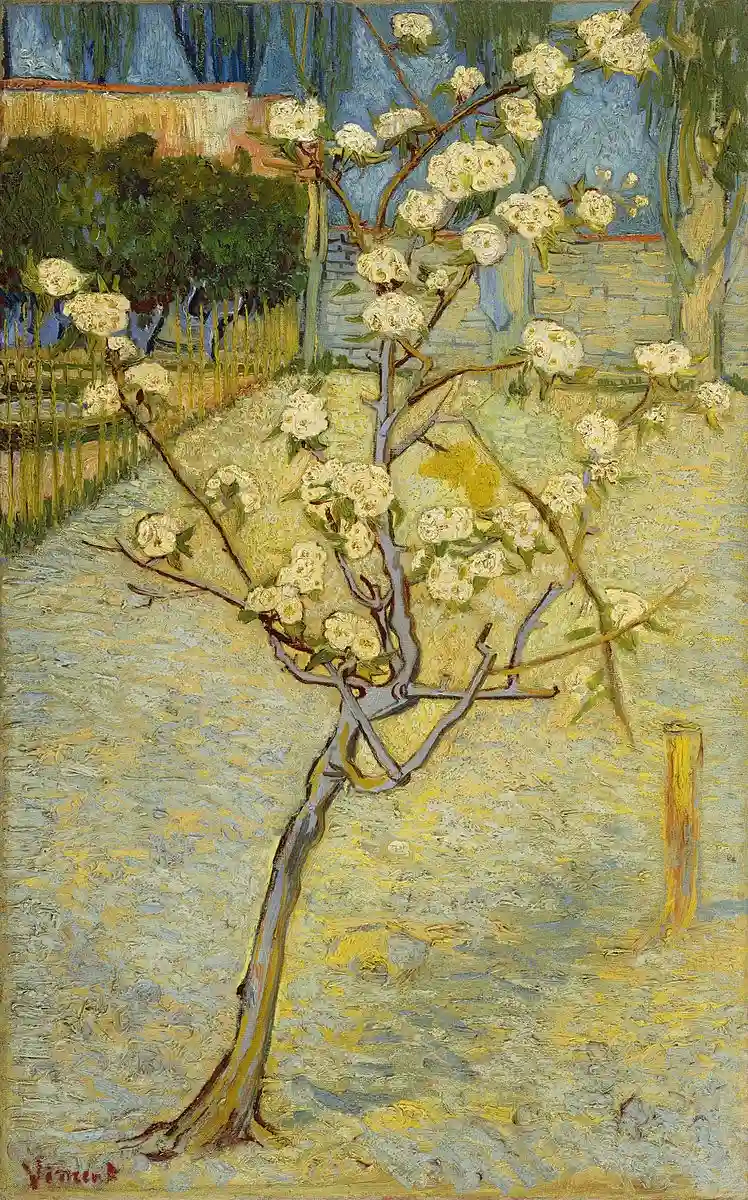Nostos
There was an apple tree in the yard —
this would have been
forty years ago — behind,
only meadows. Drifts
off crocus in the damp grass.
I stood at that window:
late April. Spring
flowers in the neighbor’s yard.
How many times, really, did the tree
flower on my birthday,
the exact day, not
before, not after? Substitution
of the immutable
for the shifting, the evolving.
Substitution of the image
for relentless earth. What
do I know of this place,
the role of the tree for decades
taken by a bonsai, voices
rising from tennis courts —
Fields. Smell of the tall grass, new cut.
As one expects of a lyric poet.
We look at the world once, in childhood.
The rest is memory.
by Louise Glück

Gustave Caillebotte Apple Tree in Bloom (1885)
I do not agree with Glück’s assessment, “We look at the world once, in childhood. The rest is memory.” We look at the world – able to see it – a million times, if we only move about with intention. Or share in the wonder expressed by next generations. Or allow art to be more than representation, pointing us to the beauty inherent in the real world. Maybe we can’t return to the exact childhood tree, but there are plenty apples around.
In some funny way, the title of the poem, Nostos, makes that very point, doesn’t it? The term comes from ancient Greece and refers to the homecoming of the hero after a prolonged absence (one of the main themes of the Odyssey.) Not remembered, but re-experienced, connected again, the world seen, not just recalled. If it was only about a particular childhood garden, it should have been Nostalgia, the combination of Nostos /homecoming with the word Algos/pain, although nostalgia most often descends into this sentimental wistfulness that I can’t stand.
Back to spring: In today’s images, spring has returned, after a long absence. So has this viewer, in my annual exploration of spring’s bounty, seeing it afresh. And so have paintings, that are not molding in museums, but here, in front of our eyes, conveying a shared appreciation of this season. Forget memory! Here are this week’s perceptions, on walks punctuated by heavy rains and sudden reappearance of the sun.

Max Beckmann SPRING NEAR SÜDENDE (1907)

Hawthorne blossoms shimmered through the trees, or exploded in full view.

Dwight William Tryon Spring (1893)




David Hockney Hawthorne Blossom Near Rudston (2008)
Cows were curious as to what I had to offer…

Doris Lee, Blossom Time, 1959


Plants unfurled, echoing van Gogh’s brush strokes.

Vincent van Gogh, Green Wheat Fields, Auvers, 1890

Meadows exploded with Camassia, and other early spring blooms, many reminiscent of rockets, all shooting towards the light.

Janene Walkky Common Camas or Camassia quamash (2013)









Ruth Asawa, Spring, 1965, lithograph
Then there are the fruit tree blossoms, holding up their own against the orange bloom,

Vincent van Gogh Orange Blossoms (1890)





Claude Monet Spring (Fruit Trees in Bloom) (1873)
Walking through the woods was a green, dripping, wet experience, then sunbursts the next minute.

Abbott Handerson Thayer Landscape at Fontainebleau Forest (1876)



Did someone say birds? Ducklings! Orioles, yellow rump warblers (butter butts!), kill deer, wood ducks, geese, barn swallows and purple martins all showing off.

Magnus von Wright Mallard Ducklings (1841)


Tracey Emin Believe in Extraordinary (2015)









AUDUBON bird Red-Breasted Nuthatch Purple Martin (1890)



Even the turtles came out.

The only thing I could not find were these:

Franz von Stuck The sounds of spring (1910)
Maybe they went that way.

Music captures it all.

